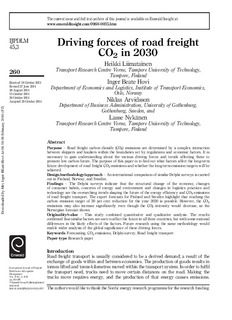| dc.contributor.author | Liimatainen, Heikki | |
| dc.contributor.author | Hovi, Inger Beate | |
| dc.contributor.author | Arvidsson, Niklas | |
| dc.contributor.author | Nykänen, Lasse | |
| dc.coverage.spatial | Norway, Sweden, Finland | nb_NO |
| dc.date.accessioned | 2019-12-18T12:18:49Z | |
| dc.date.available | 2019-12-18T12:18:49Z | |
| dc.date.created | 2015-06-30T09:31:11Z | |
| dc.date.issued | 2015-04-07 | |
| dc.identifier.citation | International Journal of Physical Distribution & Logistics Management. 2015, 45 (3), 260-285. | nb_NO |
| dc.identifier.issn | 0960-0035 | |
| dc.identifier.uri | http://hdl.handle.net/11250/2633927 | |
| dc.description.abstract | Purpose – Road freight carbon dioxide (CO2) emissions are determined by a complex interaction between shippers and hauliers within the boundaries set by regulations and economic factors. It is necessary to gain understanding about the various driving forces and trends affecting these to promote low carbon future. The purpose of this paper is to find out what factors affect the long-term future development of road freight CO2 emissions and whether the long-term emission targets will be achieved. Design/methodology/approach – An international comparison of similar Delphi surveys is carried out in Finland, Norway, and Sweden. Findings – The Delphi surveys indicate that the structural change of the economy, changes of consumer habits, concerns of energy and environment and changes in logistics practices and technology are the overarching trends shaping the future of the energy efficiency and CO2 emissions of road freight transport. The expert forecasts for Finland and Sweden highlight that reaching the carbon emission target of 30 per cent reduction for the year 2030 is possible. However, the CO2 emissions may also increase significantly even though the CO2 intensity would decrease, as the Norwegian forecast shows. Originality/value – This study combined quantitative and qualitative analysis. The results confirmed that similar factors are seen to affect the future in all three countries, but with some national differences in the likely effects of the factors. Future research using the same methodology would enable wider analysis of the global significance of these driving forces. | nb_NO |
| dc.language.iso | eng | nb_NO |
| dc.publisher | Emerald Group Publishing Limited | nb_NO |
| dc.rights | Attribution-NonCommercial-NoDerivatives 4.0 Internasjonal | * |
| dc.rights.uri | http://creativecommons.org/licenses/by-nc-nd/4.0/deed.no | * |
| dc.title | Driving forces of road freight CO2 in 2030 | nb_NO |
| dc.type | Journal article | nb_NO |
| dc.type | Peer reviewed | nb_NO |
| dc.rights.holder | Copyright © 2015, Emerald Group Publishing Limited | nb_NO |
| dc.description.version | acceptedVersion | nb_NO |
| cristin.unitcode | 7482,0,0,0 | |
| cristin.unitname | Transportøkonomisk institutt | |
| cristin.ispublished | true | |
| cristin.fulltext | postprint | |
| cristin.qualitycode | 1 | |
| dc.identifier.doi | 10.1108/IJPDLM-10-2013-0255 | |
| dc.identifier.cristin | 1251499 | |
| dc.source.journal | International Journal of Physical Distribution & Logistics Management | nb_NO |
| dc.source.volume | 45 | nb_NO |
| dc.source.issue | 3 | nb_NO |
| dc.source.pagenumber | 260-285 | nb_NO |

